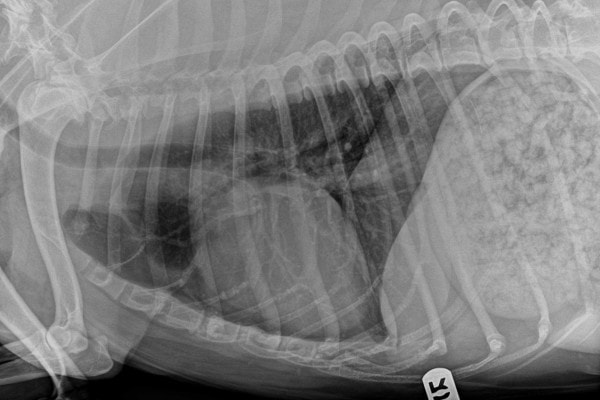Congestive heart failure (CHF) in dogs occurs when the heart can no longer pump enough blood to the tissues. It can be the end result of a variety of heart diseases. To help you better understand congestive heart failure, integrative veterinarian Dr. Julie Buzby explains the causes, signs, diagnosis, treatment, and prognosis for CHF in dogs.

If your vet recently diagnosed your dog with a heart condition, the potential for congestive heart failure (CHF) might be weighing heavily on your mind. You know your dog seems fine now, but how long will he or she stay that way? Will you be able to recognize the symptoms of CHF and know what to do if you see them?
The old adage that “knowledge is power” holds true here. One of the ways you can help your dog (and put your mind at ease a bit) is to learn all you can about congestive heart failure in dogs. That way, you will be as prepared as possible to support your dog in this journey, identify the early signs of heart failure, and get your dog the help he or she needs.
What is congestive heart failure in dogs?
Congestive heart failure (CHF) is a condition where fluid accumulates in a dog’s lungs, abdomen, or both, as a result of the heart’s inability to pump sufficient blood to the lungs and the rest of the body. As a dog’s heart starts to fail, multiple changes occur that culminate in the development of CHF.
The body tries to compensate for decreased heart function
The ability of the heart to maintain blood and oxygen flow throughout the body is crucial for survival. Thus, the body has several compensatory mechanisms that it will put into play if the heart doesn’t work properly.
Since a failing heart isn’t pumping as much blood out, the blood pressure may start to fall initially. This means less blood is getting to the tissues. In order to maintain blood pressure, the renin-angiotensin-aldosterone system (RAAS) will tell the small arteries to constrict. However, this change also increases the workload of the heart because it makes it harder to push blood out into the constricted vessels.
Additionally, in an effort to maintain circulation, the body will start conserving sodium and water under the influence of RAAS and anti-diuretic hormone (ADH). This increases blood volume, which means there is more blood available for circulation. But it also means that now there is even more blood that the heart needs to try to handle. As a result, the heart becomes volume overloaded and the chambers of the heart become larger.
In an effort to try to get more blood out to the tissues, the heart will also start to beat faster and contract more strongly. However, this also increases the workload on the heart.

The heart can no longer keep up with pumping blood
While all of these changes may initially preserve circulation, they do take a toll on the heart. And eventually, there comes a time when the heart can no longer pump sufficient blood out to the body or the lungs. This is referred to as “forward failure.”
Plus, blood backs up into the lungs (if the left side of the heart, which receives blood from the lungs, is failing) or into the body (if the right side of the heart, which collects blood from the body, is failing). This occurs because not enough blood is leaving the heart to make room for more blood, and it is called “congestive heart failure.”
The resulting blood traffic jam increases the hydrostatic (i.e. fluid pressure) within the blood vessels. This pushes fluid out of the vessels and into the tissue. If this occurs in the lungs, the end result is pulmonary edema. And if it occurs in the body, the abdomen fills with fluid (i.e. ascites). Or in some cases the dog develops pleural effusion (i.e. fluid in the space around the lungs) or pericardial effusion (i.e. fluid in the sac around the heart).
What causes congestive heart failure in dogs?
Essentially any heart disease in dogs that causes the heart to not be able to pump blood efficiently or fill with blood appropriately, or causes more blood than normal to pass through portions of the heart can potentially lead to CHF. However, some of the more common causes of dog heart failure include:
Mitral valve disease
When the mitral valve, which lies between the left atrium (i.e. top chamber) and left ventricle (i.e. bottom chamber), doesn’t close tightly, blood can leak backward through the valve. Significant mitral valve disease in dogs can lead to volume overload and left-sided CHF. Or if the tricuspid valve (i.e. valve separating right atrium and ventricle) is leaking, the dog can have right-sided CHF.
Dilated cardiomyopathy
Dilated cardiomyopathy (DCM) occurs when the heart chambers enlarge and lose their ability to contract as strongly to pump blood out of the heart. As a result, dogs with DCM may go into left-sided CHF, sometimes seemingly quite rapidly.
Patent ductus arteriosus
If the ductus arteriosus, a fetal blood vessel, doesn’t close after birth, too much blood can move from the aorta (large vessel taking oxygenated blood to the body) to the pulmonary artery (large vessel taking deoxygenated blood to the lungs). The end result can be left-sided congenital heart failure.
Subaortic stenosis
If the area under the aortic valve (i.e. valve controlling flow of blood from the left ventricle to the aorta) is narrower than normal, it takes more pressure to pump the blood out into the aorta. Thus, subaortic stenosis in dogs may lead to left-sided CHF.
Ventricular septal defect
If there is a ventricular septal defect (i.e. hole between the left and right ventricles that is present at birth), extra blood can flow from the left ventricle to the right ventricle. Over time, this can lead to left-sided congenital heart failure.
Heartworm disease
The presence of heartworms can damage the pulmonary arteries and the right side of the heart. Therefore, heartworm disease in dogs can lead to right-sided CHF.
Which dogs are prone to congestive heart failure?
With such a wide range of causes, it is probably no surprise that CHF can occur in dogs of any breed, sex, or age. Smaller dog breeds are more prone to mitral valve disease. And larger breeds are more likely to have congestive heart disease because of DCM. Additionally, smaller breeds tend to have CHF when they are seniors. But larger breeds with DCM might develop CHF closer to middle age.

What are the signs of congestive heart failure in dogs?
As a dog develops congestive heart failure, the symptoms you see will be dictated in part by the severity and location of the fluid accumulation.
Symptoms of left-sided CHF
In dogs with left-sided CHF (the most common type), fluid build-up occurs mostly in the lung tissue. Thus, symptoms of left-sided congestive heart failure may include:
Coughing
A dog coughing and gagging is a common sign of congestive heart failure in dogs. When fluid accumulates in the lungs, it triggers the dog to cough. Usually this is a moist-sounding productive cough. However, dogs can also cough due to an enlarged large heart pushing on their airway. This causes a more dry, non-productive cough. (Plus, dogs can cough for reasons unrelated to the heart.) Thus, coughing doesn’t always signal congestive heart failure in dogs.
Rapid breathing
An elevation in a dog’s sleeping respiratory rate (greater than 36 breaths per minute) can be one of the early signs of heart failure in dogs. Additionally, especially as heart failure worsens, you may notice your dog breathing fast. Pulmonary edema (i.e. fluid in the lungs) makes it harder for a dog to breathe and can cause respiratory distress.
Collapse or fainting (i.e. syncope)
Your dog may suddenly look weak or fall over. If he or she passes out (i.e. becomes briefly unconscious), this is called syncope. In some cases, syncope can look a bit like seizures in dogs.
Blue or purplish gums
In worsening heart failure, if a dog isn’t getting enough oxygen, his or her gums may turn a bluish purple color.
Lethargy
If your dog has pulmonary edema or enough blood isn’t getting to the tissues, he or she may lay around more and not want to be as active. A lethargic dog may also seem more tired than normal.
Lack of appetite
Your dog may not want to eat well, especially if he or she is having trouble breathing.
Weight loss
You may notice your dog looks thinner or his or her bones are more prominent. This is cardiac cachexia, and it occurs in some dogs with heart disease.
Exercise intolerance
Your dog may quickly become winded when trying to be more active. Or he or she may not be willing to exercise.
Abnormal posture
If your dog is struggling to breathe, he or she may stand with the neck outstretched and the elbows winged out from his or her sides. This posture is called orthopnea, and it is a sign of worsening heart failure.
Reluctance to lay down
If your dog is having trouble breathing, he or she may not be willing to lie down. This is the case because it is harder for a dog with CHF to breathe when lying down.
Signs of right-sided CHF
On the other hand, dogs with right-sided CHF tend to have fluid accumulating in their abdomens or around their hearts or lungs. Some of the common symptoms of right-sided congestive heart failure in dogs include:
Enlarged abdomen
Due to fluid build-up in the abdomen (i.e. ascites), you might notice your pup has a pot-belled dog appearance with a large and pendulous abdomen. And if you palpate your dog’s belly gently, it may feel like a water balloon.
Difficulty breathing or increased respiratory rate
The fluid around the lungs can make it hard for the lungs to fully inflate. This may lead to trouble breathing if severe.

Cough
You may notice your dog is coughing with increased frequency.
Prominent jugular veins
The veins in your dog’s neck might stick out due to back-up of blood as it waits to get into the right side of the heart.
Edema of the legs
Occasionally, dogs with right-sided heart failure may have fluid build up in the limbs or the tissue under the skin. This may cause the legs to look swollen or the skin to feel squishy.
Non-specific signs
Like with left-sided heart failure, dogs with right-sided heart failure may be lethargic, losing weight, not eating well, intolerant of exercise, or unwilling to lie down.
If you see symptoms of CHF, rush to the vet
Should you notice some of the symptoms of congestive heart failure, it is imperative you get to your vet ASAP or make an emergency vet visit. Dogs can die from congestive heart failure. And it is distressing for a dog to feel like he or she can’t breathe. Thus, you need to take action right away if you think your dog has CHF. Don’t sit around wondering, “Should I take my dog to the emergency vet?”. Just go!
How will the vet diagnose a dog with congestive heart failure?
When you arrive at the vet’s office or emergency room, the first thing the veterinary team will do is triage your dog. This involves taking your dog’s vital signs and determining how stable he or she is.
If your dog is in respiratory distress, the veterinary team will move fast to get your dog stabilized. Then, once your dog is breathing better, they can safely proceed with more diagnostics. However, if your dog appears stable when you arrive, the vet can move forward with performing the full examination and diagnostics at that time.
Physical exam
During the physical exam, the vet will pay special attention to the dog’s heart and lung sounds, pulses, and abdominal contour.
- Heart—Most dogs with CHF have a heart murmur in dogs. This is where the vet hears a whooshing sound in place of crisp “lub dub” of the heart beat. Some dogs with CHF may have arrhythmias too, which are an abnormal heart rhythm.
- Lungs—Due to pulmonary edema, the dog may have increased lung sounds. Or the vet may hear crackles in the lungs in severe CHF. Alternatively, with pleural effusion, lung sounds may be dull or difficult to hear.
- Pulses—Dogs with an arrythmia may have times when the vet can hear a heartbeat but not feel a corresponding pulse (i.e. pulse deficits). And dogs with right-sided heart failure may have distended jugular veins.
- Abdomen—If the dog has ascites due to right-sided heart failure in dogs, the abdomen may look larger than normal. And the vet may be able to feel a wave of fluid sloshing around in the belly.
Chest X-rays
After performing the physical exam (and stabilizing your dog if needed), the vet may want to take chest X-rays (i.e. radiographs). This is a great way for the vet to detect pulmonary edema or pleural effusion. And it allows him or her to assess the size and shape of the heart and the size of the blood vessels in the lungs.
Pulmonary edema may cause the lung fields to look more hazy than normal. And dogs with heart disease often have an enlarged heart and may have more prominent vessels in the lungs.

Echocardiogram
An echocardiogram (i.e. ultrasound of the heart) can’t diagnose CHF. But it can help give the vet a better idea of what caused the heart failure. Unlike an X-ray, which only shows the outline of the heart, an echo can look inside the heart. This allows the vet to measure the size and thickness of the heart chambers and assess how well the heart is contracting. Plus, he or she can determine the pressures in different parts of the heart, look for regurgitation of blood through the valves, and so much more.
Not all vets have the equipment and training necessary to perform an echocardiogram. So there is a good chance your vet may refer you to veterinary specialist near you, namely a veterinary cardiologist, for this test.
Additional tests
Sometimes the vet may also recommend an ultrasound of the lungs or abdomen. This can be a good way to look for evidence of fluid and rule out other cases of ascites or pleural or pericardial effusion. And he or she may want to test the fluid to get a better idea of its origin.
Additionally, the vet may suggest an electrocardiogram (ECG) to assess your dog’s heart rhythm. Or in some situations, he or she may also want to run an NT-proBNP test. This is a blood test that detects stretching of the walls of the heart, as occurs in heart disease.
What are the stages of congestive heart failure in dogs?
Based on the information the vet collects, he or she will classify your dog’s congestive heart failure into one of five stages. These are the same stages used to classify dogs with mitral valve disease.
- Stage A—The dog is at risk for heart disease but does not have any changes to the heart structure.
- Stage B—Evidence of heart disease is present but the dog isn’t showing signs of CHF.
- Stage B1—The dog is asymptomatic and shows little to no heart changes on imaging.
- Stage B2—Still asymptomatic but there are severe heart changes that warrant medications.
- Stage C—The dog has or once had clinical signs of CHF due to heart disease.
- Stage D—The dog is in end-stage heart failure and the vet is unable to treat congestive heart failure with the standard approach.
Unfortunately, there is no cure for congestive heart disease. But if it is caught in the early stages, treatment can slow the progression.
How is congestive heart failure in dogs treated?
The vet will base the treatment for congestive heart failure on the stage of heart failure, the underlying cause, and whether the dog has left-heart failure, right-heart failure, or both sides of the heart are failing. Initially, the goal for dogs with acute CHF is to mitigate clinical signs in the hospital. Then, once the dog is stable and able to go home, the focus changes to maintaining a good quality of life with medications used in the acute phase.
Treatment of acute left-sided congestive heart failure in dogs
Dogs who have acute left-sided CHF may require oxygen therapy to help them breathe. And the vet may use injectable diuretics (e.g. furosemide) to help remove edema fluid from lung tissue. Additionally, the vet may start the dog on pimobendan (Vetmedin®). This medication can increase the strength of the heart muscle contraction to help improve heart function.
In severe cases, the vet may give your dog nitroglycerin to dilate blood vessels leading up to the heart. And since being in congestive heart failure can be stressful for a dog, the vet may use anti-anxiety medications to help keep your dog calm. If arrythmias are a problem, the vet might also start your dog on anti-arrhythmic medications.
Treatment of acute right-sided congestive heart failure
Some aspects of the treatment of right-sided CHF are similar to left-sided CHF. The vet may still administer furosemide, oxygen therapy, anti-anxiety meds, and pimobendan for treatment. But he or she might also use a needle to remove the fluid that has accumulated around the heart or lungs, or in the abdomen.
At-home treatment for left-sided congestive heart failure
Once a dog is well enough to go home from the hospital, he or she may require a few different medications to treat congestive heart failure long-term. Furosemide (or sometimes also other diuretics) can reduce fluid build-up and help a dog who is coughing from congestive heart failure. Plus, dogs will commonly stay on Pimobendan to help improve heart function. And the vet may recommend angiotensin converting enzyme (ACE) inhibitors (which block RAAS). ACE inhibitors, such as enalapril for dogs, can dilate blood vessels to decrease the workload of the heart.
Dogs with CHF can also benefit from diets that are low in sodium. Low sodium foods can decrease fluid volume in the body, thus lowering the risk of fluid moving from the vessels to the tissues. There are veterinary prescription diets that fit this bill well. Alternatively, veterinary-approved homemade dog foods may be helpful for dogs with congestive heart failure. But these homemade diets must be balanced by a veterinary nutritionist to avoid any deficiencies.
Additionally, your vet may recommend natural supplements to improve heart health. Some research suggests that omega-3 fatty acids for dogs (i.e. fish oil supplements) can help dogs with heart disease. And some dogs may benefit from heart health supplements containing amino acids such as taurine and L-carnitine. Both may have the ability to improve blood flow and the oxygenation of blood cells.
At-home treatment for right-sided congestive heart failure
Dogs with right-sided CHF may also benefit from diuretics, ACE inhibitors, pimobendan, special low-sodium diets, and heart-health supplements. Additionally, the vet may need to drain the abdomen or space around the heart or lungs if they fill with fluid again. And dogs with some forms of right-sided CHF might benefit from sildenafil (i.e. Viagra ®) because it decreases pressure in the pulmonary arteries. Or they may need anticoagulants to decrease the risk of clots forming in the lungs.
What sort of monitoring and care do dogs with CHF require?
In addition to giving all medications as directed, it is very beneficial to keep a close eye on your dog’s breathing. Often, the vet will recommend keeping a log of your dog’s sleeping respiratory rate. If the number starts to deviate from the normal baseline, or if it is over 36 breaths per minute, this may mean the dog is starting to develop CHF.
If you notice mild elevations in respiratory rate, you should give your vet a call. But if you see signs of respiratory distress such as open-mouth breathing or your dog becomes weak or collapses, head to the ER right away.

Since heart medications can affect kidney health, your vet may want to run blood tests for dogs in the first one to two weeks after starting meds. Plus, keep in mind that dogs on diuretics tend to drink a lot and therefore urinate a lot. This may mean they start having urinary accidents in the house. But in order to protect the kidneys, please avoid restricting access to water. Instead, take your dog out more frequently.
Finally, keep an eye on your dog’s appetite. If your dog with CHF is not eating, this might be occurring for a few reasons. One could be stomach upset. Heart medications can cause vomiting and diarrhea in some patients. Another reason could be difficulty breathing. In both situations (but especially if you think your dog isn’t breathing well), it is important to contact your vet.
And as always, before making any changes to your dog’s medication regimen, be sure to reach out to your veterinarian for advice. Let him or her know what you are noticing at home. Then follow his or her suggestions, be that to change up the medications or to come in for an appointment.
What is the prognosis for dogs with congestive heart failure?
The prognosis for dogs with CHF is fair to guarded, depending on the underlying cause. Unfortunately, because heart disease is usually progressive, most dogs will eventually die or be euthanized due to CHF. However, if they respond well to therapy and their clinical signs are under control, dogs can live for months or years with a good quality of life.
Since so much depends on your dog’s particular heart condition and overall health, your vet or veterinary cardiologist is often the best person to give you an idea of your dog’s potential life expectancy. And he or she can also help you comfort your dog with congestive heart failure and know when it is time to say goodbye.
Because left-sided CHF involves fluid building up in the lungs, it can have a significant impact on your dog’s quality of life. Difficulty breathing is very distressing for dogs. So sometimes the kindest thing may be to euthanize your dog if he or she is in end-stage heart failure and the symptoms are no longer controllable.
Be observant and partner with your vet
I know we ended on a sad note. But I want to encourage you not to give up. While your dog is still fighting CHF, there are things you can do to help him or her. You are your dog’s advocate and know him or her better than anyone else. So you are the perfect person to notice subtle changes in your dog’s breathing, appetite, or activity level that may signal the onset of CHF. When you see those indicators, trust your dog parent instincts and contact your vet.
Your vet can modify your dog’s medications, help monitor your dog, and make recommendations to keep your dog happy and healthy for as long as possible. By being an observant, proactive dog parent and partnering with your vet and/or a veterinary cardiologist, you can make a huge difference for your dog with CHF.
Have you had a dog with congestive heart failure?
Please share your dog’s story or any words of encouragement with fellow dog parents.


where can you find that creative cough for the coughing that mine is exhibiting
Hi Robin,
I would love to be able to offer you some guidance and advice. Unfortunately, I am a bit confused as to what exactly you are asking about. Can you give me more details?
my dog was rushed to the er vet because he was basically drowning inside. he had just had a cardio work up but was having issues with dehydration. the put fluid under the skin and he coughed all night the first night. I was already monitoring hus breathing so when he was in the 60s and holding his head up and walking in circles, we went to the er vet at 3 am. we were able to save him. that was November. he’s responded well to treatment but is anxious all the time now. His brother (litter mate), Little Bit showed signs and we immediately got him on vetmedin and did a cardiac workup. he’s on a small dose of ferosumide but great. they eat and drink well. I do have to put my Louis in a wrap at night because of his high dose of ferosumide. they will be 15 on the 8th. I am blessed everyday I have my boys. They are eating well and Little Bit constantly grooms Louis. I am so blessed.
Hi Heather,
What a blessing both of your boys are doing well and responding favorably to treatment. Thank you for sharing your experience with us. Wishing you continued success and many happy days ahead.
We lost our dear Chai two months ago. We knew that he had a heart murmur and was taking pimobendan. We noticed he stopped eating (which was very weird for him) and lost a bunch of weight. We took him to the vet and said nothing was wrong. Then he started having high respiratory rate at night, and it killed us to see him suffering. He couldn’t sleep, but in the morning he seemed to go back to normal. We took him to the vet twice more because we were so worried, and she said that it was probably allergies. He started fainting on our walks. On our way to Austin he has one of those fast respiratory rate “attacks” and we didn’t know what to do because we were under the false impression (due to what that vet said) that I was allergies. My husband and I ended up taking him to the emergency vet, where they put him in the Oxygen chamber and gave him furosemide. But it was too late for him. We have cried so much for our baby and feel so angry at the incompetence of the vet. His mother, Luna, is still with us. She also has a heart murmur and we are taking all the precautions to give her the best quality of life we can, taking her to the cardiologist this week to see what her evolution and prognosis is. So devastating to having yo go through this twice. Just hoping the experience with Chai can make this a bit less stressful and traumatic for everyone.
Dear Sophie,
My heart aches for you with your tragic loss of Chai. It is clear he was dearly loved, and I am certain he knew how much he meant to you. What a blessing you still have Luna by your side. She is very lucky to have you advocating for her health and well-being. I hope your appointment with the cardiologist went well and was informative. Praying for comfort and healing for your heart. Wishing you brighter days ahead as you continue life’s journey.
Sometimes it just hits fast and hard and there is no time for diagnosis. It’s incurable and once they start coughing (which is also usually one of the first signs) they’re done.. They’ll never be the same. They’ll be on several medications and they’ll hang on but they’re suffering. My dogs congestive heart failure played out in about a week total. She started getting a lil wheezy then started having gagging dry heave episodes. Started having issues with exercising and stopped eating all in about three days. Vet thought it was the nystery respiratory crap that’s going around everywhere. Then she actually got better first couple days. She was up eating and drinking and no coughing fits and the second day I was giving her a bath and she went into convulsions. Convulsed all the way to the Emgc Vet Hospital and buti.e we got there her eyes were a lil bulgy and wouldn’t track anymore and were turning grey. It was horrific. And she was very healthy otherwise. She was a Chorkie and just turned 12 a bit before she passed away last Saturday.
Dear Clay,
My heart aches for you with the tragic loss of your girl. I am sorry things progressed so rapidly and left you without time to truly process what was happening. I hope with time your heart can begin to heal and the grief will fade. May her memory be with you always as you continue life’s journey. ♥
My dog Royce a Yorskshire Terrier was just doagnosed with heart disease (enlarge heart). He is 12. I knew something was wrong, when I took his to the vet six months ago. I told them that he had a cough but only coughed when he returned from walks but never coughed during the walk. They gave him Creative Cough, it did not seem to help then i noticed, he was losing weight, and i begin to feel his ribs. To make a long story short, the coughing got worse to where he was unable to sleep, each time, he laid down he would wake up coughing. I called the vet o nce again to talk about the cough. I scheduled the appointment but it was m ore then two weeks off, he began coughing so badly I took him to a 24/7 Vet hospital, she did a exam and immediately told me he had heart disease. He is now o n Lasix and Creative Cough to try to suppress the cough. I admit the cough is not as bad, loud or frequent but it should have been caught earlier.
Hi Sam,
I am sorry Royce is living with heart disease. I am glad he responded favorably to the medications and his cough has improved. Hoping he will continue to maintain his health and quality of life for as long as possible. Wishing you both nothing but the best.
My 12 year old Chihuahua was diagnosed with left sided CHF! She is taking 3 different meds! She hates taking her meds. After, staying overnight with inpatient facility on O2, Lasix, 2 other meds, and a catheter, we were able to bring her home! She still wags her tail, is urinating well, and she is eating and drinking, she just seems drugged, and pitiful! I think we caught it too late! She had been coughing and trying to spit up sputum, but we thought it was because she likes to eat anything on the floor! We don’t wanna give up on her, but don’t want her to suffer! Please pray we are doing the right thing, and not just prolonging the truths of her disease! This is killing us, and her sissy, just wants her back to normal! We are so hearbroken and devastated!
Dear Stephanie,
I am sorry your senior girl is struggling with congestive heart failure. It sounds like the veterinary team did a great job getting her stabilized. Hoping her medications will be able to offer relief and she can maintain her quality of life for a while longer. Here is a link to another article that provides great information on what to watch for when she is nearing an end stage of life: Signs of a Dog Dying of Heart Failure
Wishing you strength as you walk this emotional path. Bless you and your sweet girl.
My large greyhound collapsed and died and I suspected a heart issue. From the descriptions here it seems quite likely. Sadly my vet failed to respect my warning signs because they were not evident in the clinic. And he did not respect me! Get a second opinion if you see suspect symptoms and behavior in your animal!
Dear Joanne,
My heart aches for you with the tragic loss of your Greyhound. I am sorry for the negative experience you had with your vet and hope in the future you can find one in which you can place your trust. Thank you for sharing your story with us. Wishing you brighter days ahead.
Hi, I have a Yorkshire terrier named Macy. She will be 14 in June. She has many health issues. She has a leaky heart valve and is treated with heart medicine, vitamin for that and is also on a water pill once a day heart pill twice a day. She is also diagnosed with Cushing’s disease, not on any medication for that because I believe the federal gave her a seizure after being on it for two weeks that was last year. She also has what they call a collapsed trachea. She is still eating a little fussy at times back legs I see are getting weaker harder for her to walk up her doggy steps and the cough sometimes can get bad at night some days depending on the weather she will walk. She always enjoyed walking but now I noticed she starting to tremble a little bit. I know she is very weak and her stomach is getting distended I guess from the Cushing’s disease , it’s so hard I know she is restless sometimes at night, especially coughs more after drinking bouts of water and one waking up from sleeping. She still alerts me though when she hast to go to the bathroom, which is a good thing she still has spunk in her loves laying on the back of the couch, looking out the window, barking at anybody that walks by , so she is totally not lethargic yet but I know they say you know when the time comes, but I look at her sometimes, and I just wonder if she is suffering I will not give her hydrocodone as was recommended by one of my vets because it made her very disoriented and dazed I couldn’t wait till it were off. I told that to the vet and she says don’t give it to her anymore so basically she is just on heart medicine other than I do give her and holistic a little black tea pill that was prescribed by a holistic doctor to help with her anxiety not sure every day is a gift from God with her. Just needed to talk to someone about this. If you have any suggestions for me, that would be greatly appreciated. Thank you so much.
Hi Terry,
I am sorry Macy’s health is declining and she does not tolerate her medications very well. I wish I had some great advice, but I think you already said what I was thinking…. every day is a gift! Make the most of the time you are gifted and spoil your girl rotten. It sounds like you are doing everything you can, and I applaud you for taking such an active role in advocating for Macy’s well-being. Wishing you all the best and praying for many happy days ahead. Bless you and your sweet girl.